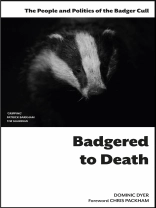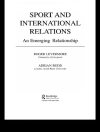A vital read for anyone who cares about the future of British wildlife. With a foreword by the BBC TV presenter Chris Packham.
'A thriller, whodunnit and impassioned polemic.' – PATRICK BARKHAM, THE GUARDIAN
Dominic Dyer explores the science and electioneering behind Britain's most controversial wildlife policy: the badger cull.
He exposes the catastrophic handling of bovine TB by the British government, the political manoeuvring that engineered the badger cull in 2010, and the ongoing close relationship in perpetuating the cull between the National Farmers Union and the Department of the Environment, Food and Rural Affairs (DEFRA).
He shines an unflattering spotlight on Cabinet ministers, the veterinary profession, environmental NGOs and the BBC.
Reviews
'I enjoyed reading this book and I strongly recommend it to you.
'This is a powerful and stimulating read and it's bang up to date with the important issue it discusses. It is written by a passionate insider with years of experience. The narrative is pacey and exciting. This book arrived with me on Thursday afternoon and I had read it completely by early yesterday [Saturday] morning.'
– MARK AVERY, WRITER, BLOGGER AND ENVIRONMENTAL CAMPAIGNER
'A vital must-read for anyone concerned about the badger's enduring place in the British countryside.
'A thriller, whodunnit and impassioned polemic, this is the inside story of the badger cull.'
– PATRICK BARKHAM, THE GUARDIAN
'It should be read by all those battling against government policies that put money ahead of science and the environment.
'The book's conclusion is that the culls will be stopped, not by science or validity, but by cost. Yet Dyer remains optimistic: 'Despite all the incompetence, negligence and deceit, it's the caring compassionate British public who have made a stand for wildlife that gives me the most hope for the future.'
'His book pays tribute to the 'Badger Army', those many individuals from all walks of life who turned out to protest and importantly, once culling started, to protect the badgers out in the field.
'Those people will be patrolling the countryside, day and night, in every area where badger killing is taking place this autumn. While determined to protect their badgers, many also want to see the government help and support farmers to beat the TB in their cattle – but with proper cattle-based measures, not by senselessly killing wildlife.'
– LESLEY DOCKSEY, THE ECOLOGIST, 'Why are our badgers 'Badgered to Death'?'
Introduction by Chris Packham
How viciously fickle we are. We arbitrarily pick and choose which species we like or dislike, normally and sadly based on purely anthropomorphic criteria, and then either laud or loathe them paying scant attention to the realities of their lives, or ours. And once cursed and demonised that tag is almost impossible to redress. Think rat, think fox… damned for historical crimes, firmly fixed as malevolent vermin, even in our supposedly enlightened age. But as this book displays we can also be quick to destroy the reputation of our animal heroes and blight their status with bigotry and ignorance.
For many reasons we had come to love the badger, to cherish and admire it, to protect and celebrate it and of course many still do. But the reputation of this essential member of the UK’s ecology has been targeted by a smear campaign which has been swallowed by the gullible and fuelled by those with vested interests. You see, in spite of all the science and all the truths that it outlines, the badger has become a scapegoat. Its been branded a ‘bad guy’ and is being persecuted as such. It’s a terrible shame, but like I said, how fickle, how vicious, how predictably human.
Buy the book and carry on reading Chris Packham's introduction
表中的内容
INTRODUCTION. Wildlife campaigner and Springwatch BBC presenter Chris Packham says that 'the reputation of this essential member of the UK’s ecology [the badger] has been targeted by a smear campaign which has been swallowed by the gullible and fuelled by those with vested interests.'
‘It is very clear to me that the government’s policy does not make sense.’ Lord Robert May, President of the Royal Society and Chief Scientific Advisor, UK Government (1995-2005), speaking in 2012
1. A BLACK AND WHITE NIGHT. Campaigners in 2015 protest at the re-election of Conservative Prime Minister David Cameron in Witney, Oxfordshire, because of his party's policy of culling European badger (Meles meles), ostensibly to reduce Bovine TB in cattle
2. WOVEN INTO THE LANDSCAPE. Most people have never seen a live badger; the closest we tend to come is as we speed past a corpse on the side of the road. However, these large mammals often live in close proximity to us and there are more than 100 manifestations of the Anglo-Saxon 'broc' in place names
3. A DISEASE OF CATTLE. During an outbreak of bovine tuberculosis (TB for short) in cattle at a farm in the Cotswolds Hills scientists found Mycobacterium bovis (bovine TB) in a dead badger. The Government started and then halted gassing badgers. A study showed badgers rarely carried Bovine TB
4. NEW LABOUR. The Labour Party did not support culling. When Tony Blair's New Labour came to power in May 1997 the Ministry of Agriculture introduced a moratorium on new badger culls. The Krebs report recommended that MAFF set up an experiment to quantify the impact on Bovine TB of culling badgers
5. GORDON BROWN VETOES A CULL. In 2001, Tony Blair created the Department of the Environment, Food and Rural Affairs (Defra), which inherited higher bovine TB cases. A review by Professor Bourne of the Krebs randomised trials found only 1.65% of badgers could spread TB to cattle
6. CAMERON'S CULL. In the run up to the 2010 general election, when every rural vote would count, and with commitments already made to the NFU and Countryside Alliance to deliver a badger cull, David Cameron and his farming spokesman Jim Paice hailed a report by Chief Scientific Advisor Sir David King
7. WILDLIFE OVER BUSINESS. A chance encounter on a suburban street in Kingston upon Thames made up the author's mind to ditch corporate lobbying and campaign full-time, already being chairman of Care for the Wild, a wildlife protection charity. He first saw badgers on the Isle of Wight
8. AWKWARD FACTS. New DEFRA Secretary of State Owen Paterson Paterson made it very clear that he would not be pushed off course by growing public, political and scientific opposition to the badger cull. Bovine TB had led to the slaughter of 26, 000 cattle the previous year, he told MPs
9. THE BADGER ARMY. Protests were organised nationwide. The informal ‘Badger Army’ had become the largest wildlife protection campaign in Britain and elicited political interest as well as media headlines. After each march photos and videos were shared on Twitter, Facebook and other social media
10. GREEN MOVEMENT FAILS THE BADGER. While ordinary people across the country have protested against the badger cull, there has been a marked lack of action from the major conservation and wildlife protection NGOs. Greenpeace, Friends of the Earth, WWF, World Animal Protection have done almost nothing
11. DEFENDED BY AMATEURS. With the support of other key wildlife protection charities opposing the cull, the Badger Trust challenged the wide-ranging nature of an anti-protect injunction and its impact on the right to peaceful protest at the High Court
12. BBC BIAS. As the badger cull progressed the BBC became heavily criticised by the badger protection movement. In my view, some of this was unfair, particularly as its regional networks had given extensive coverage of the badger protection patrols in the culling zones.
关于作者
Dominic Dyer is a wildlife protection campaigner, writer and broadcaster.
He left school at 16 and joined the Ministry of Agriculture Fisheries and Food as a civil servant. Over the next 13 years in Whitehall and Brussels he worked on issues ranging from marine environment protection to organic agriculture.
In 2000 he left the public sector for the Food and Drink Federation, where he became an expert on the environment and healthy eating trends.
In 2008 he was appointed chief executive of the Crop Protection Association, the trade body for the UK plant science industry.
In 2012 he abandoned his career as an industry lobbyist and became a full-time wildlife protection campaigner with Care for the Wild.
Today he is policy advisor for the Born Free Foundation and chief executive of the Badger Trust.












